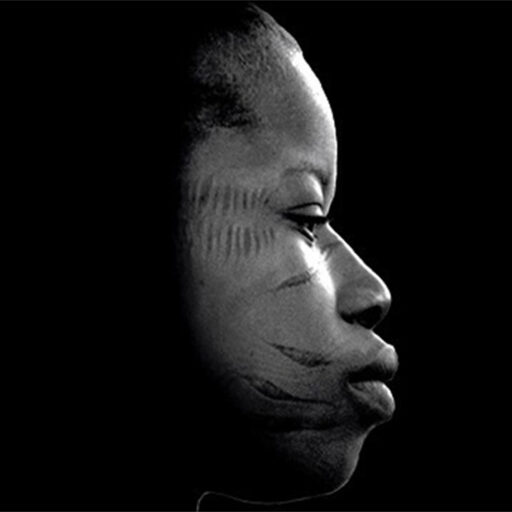Note from BW of Brazil: Haven’t we’ve seen this all before? Well, as the saying goes, here we go again! How many examples do we need to demonstrate that Brazil adores facets/attributes of Africa/African culture or blackness as long as it comes wraps in white or whitish skin. It’s nothing new in Brazil. Things that are deemed a “coisa de negro”, or a ‘black thing’ suddenly become fashionable when some discovers it can be mass marketed or presented in a more European body. About 100 years ago,black sambistas (samba musicians) were persecuted and repressed by the police, then it was marketed as ‘Brazilian Culture’ to mass market Carnaval.
Throughout history, we’ve also seen the martial art capoeira and the religion of Candomblé also violently repressed and then become ‘cool’ or ‘hip’ as those who were not originally associated with these practices began to participate. We’ve seen it happen with the sound known as funk that was and continues to be widely criticized as it spread throughout Rio’s slums. Today, it has gone through a process of homogenization and crossover perfectly exemplified in the body of a rising star whose appearance seems to have gone through a whitening process as her star continued to rise. Why, in a country that is known for appreciating a shapely bunda, apparently, even a nice ass is better in white skin! With all of these examples, today’s story should actually come as no surprise. Especially considering that in October of 2013, São Paulo Fashion Week drew inspiration from África, but placed nearly all white models on the runways. But the way Brazil has always dealt with its relationship to Africa and its descendants, none of this should come as a surprise. After all, the Brazilian dream has been that of a white nation for more than a century now!
To celebrate África, Vogue Ball of 2016 chose racism
By Stephanie Ribeiro
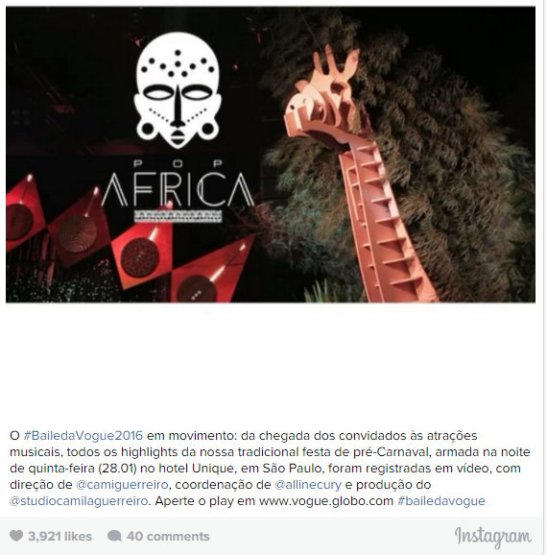
Baile da Vogue 2016
This year Vogue launched as a theme for its traditional Gala dance, “África”. The announcement of the party had already made it clear: “For those who still don’t have a costume, our African fashion guide helps you beautify yourself for the Vogue Ball of 2016.”
I truly believe that no one from this magazine and sort of fashionista has read about cultural appropriation, a subject much debated and dealt with by us black people, much less considered that using the term “costume” sounds very offensive. However, a quick search on Google and we will find several texts written by black people and even a Wikipedia article, addressing the issue of appropriation.
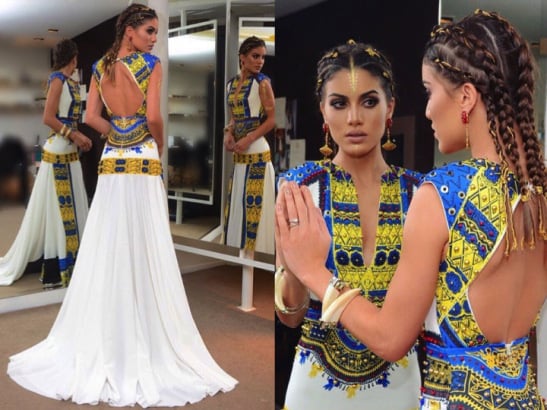
Blogger and makeup artist Camila Coelho
Basically, cultural appropriation is when a minority culture or in some way a social, political or ethnically subordinate is appropriated by a dominant culture. In the Brazilian context in which we operate in a country of 516 years and nearly 400 of enslavement of black people, there is what one considers the implications of this “fashion”. We have the culture coming from blacks as being subordinate to imposed and valued white/European culture. Models, designers and brands that profit from the appropriation are white.
When white people “dictate fashion” and make themselves the reference of style and beauty wearing turbans and dreads, it configures cultural appropriation. In this case, the turban is an ornament of religious symbolism in various cultures, including African. It emphasizes the connection of enslaved blacks connection with their original customs and represented resistance.
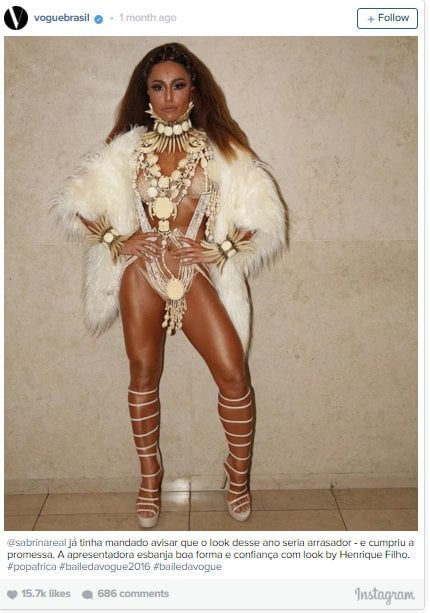
Television host Sabrina Sato
That is, the turban is not a fashion or trend, much less a prop such as earrings that we use at parties. It is a political-social element of empowerment of black people.
The dread is characteristic of Indians, Africans and other non-Western cultures and, when reproduced, people take appropriate an item that is part of the “natural beauty” of certain people, but that is also connected to the traditions.
That’s disrespectful.
Cultural appropriation is emptied in a political and militant sense, thus, what for one people is tradition for others is a costume. But it seems that Vogue and its guests are ignoring this, or don’t have knowledge about it. They put on a ball paying homage to África, however, didn’t even research about Africans and blacks of the diaspora. The result was a symbolic violence to us.
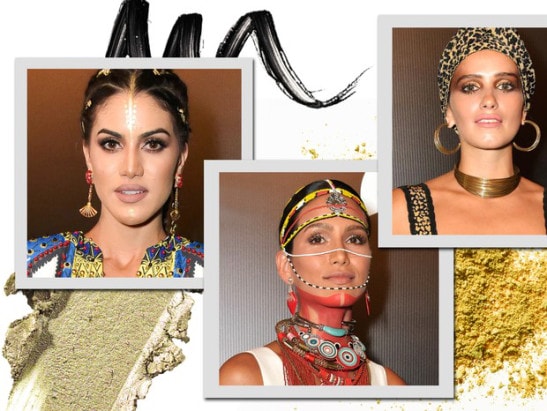
We saw guests wearing cabelo crespo (kinky/curly hair) as an accessory, an occasional fetish. Years of aesthetic impositions based on straight hair as a desired standard,magazine covers with celebrities, actresses, singers, models and their straight hair. TV series, novelas (soap operas), movies and dolls exalting their straight hair and black children growing up believing that our hair is a big problem. Then a white woman makes it a prop like a necklace, for an event? It doesn’t even seem that this year began with the debate of why a boneco negro com cabeça de palha de aço (black doll with steel wool hair) is being used in a reality show of a major network of national television. While they make our hair a joke, we blacks still suffer a lot with nasty comments coming from strangers on the street and even losing jobs.
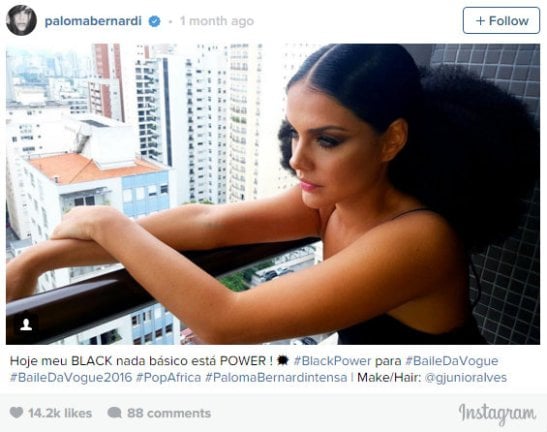
“Today my BLACK (meaning afro), nothing basic, is POWER!”
And when we think that the vexation of Vogue could not be more stratospheric, there appears one of guests in Blackface. For those who don’t understand, blackface is still racism, an old theater practice basically made by white people who, at the height of their privileges and cynicism, lampooned blacks when they made a stereotypical caricature of us, or rather, what they imagine blacks to be, reinforcing our physical characteristics that stand out in racist eyes as to them they are bizarre, with the intent of mocking, debauching, making fun of and provoking laughter…
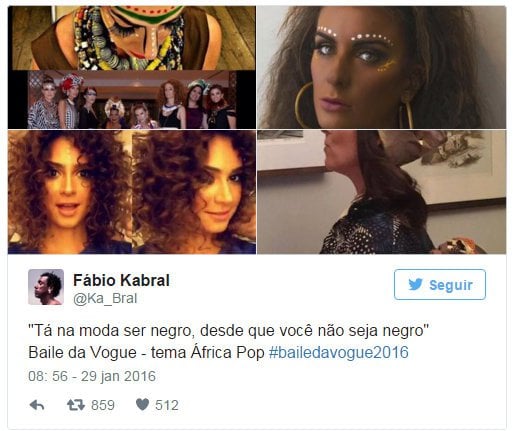
“It’s in style to black as long as you’re not black” – Vogue Ball – Africa Pop theme – ballofvogue2016 – Twitter user expresses his disapproval
Usage of this technique is, above all, to contribute to the maintenance of racist thought maintaining the hegemony of the spaces to be occupied, in which the role of formers of opinion, creators, artists and intellectuals from different spheres of art, entertainment, journalism, literature and humor make it crucial for engaged debate and so longed for change. We blacks were not there in force, but our clothes and culture were, but in a distorted way and the result of a colonialist vision.
Catastrophic interpretations of the theme
África is a very culturally diverse CONTINENT, is the third most extensive in the world and has 54 countries – in each of them there can be up to seventy different cultures.
Rounding up and summarizing in animals and even wild people, is pure ignorance and a colonizing thought. There is no “costume” representing the various Áfricas and its syncretism. In África, one wears jeans and shirts, like here. What exists are clothes that often times refer to traditions and beliefs of some peoples, that are being appropriated lightly by people who refuse to see África with a rich, human and non-colonizing view.
The ball highlighted the use of animal prints, in addition to turbans. Some people even thought it to be referring to the Egyptian culture, however they were again disrespecting what they didn’t know wearing costumes that bordered on the bizarre.
We are here talking about a ball, which had a majority of its guests, personalities, professionals of the world of fashion, photographers and other distinguished whites in a country of a black majority, this black majority which is intrinsically connected by its past to the African continent that is not truly represented on the covers of Vogue Brasil (in 40 years we’ve had less than 10 covers with black people, that’s a shame) (1), in the edicts of fashion of Vogue Brasil nor among people who work in Vogue Brasil.
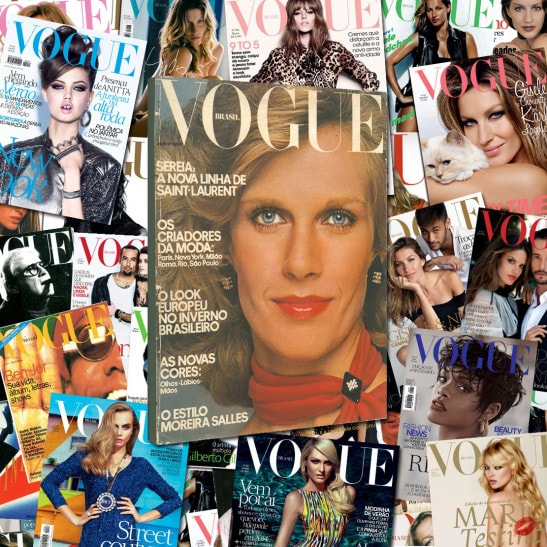
Collage of Vogue Brasil covers
Never do I see black stylists and black models being really valued by the magazine, besides really loving fashion, I still find this an elitist and racist environment where I hardly feel represented. Valetino paraded a collection inspired by África without blacks, the Farm brand represented Iemanjá, a black goddess worshiped in religions of African origin, with a white woman, Vogue, in an editorial made it clear that black women should not wear red hair.
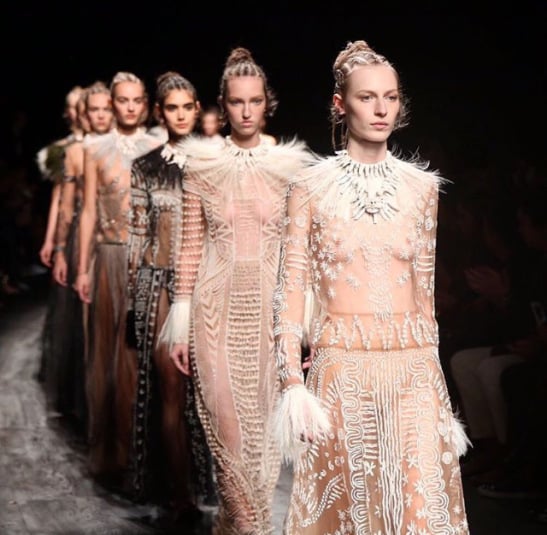
Valentino spring/summer 2016 collection draws inspiration from Africa but ‘forgets’ black models. Only 8 of 89 looks featured black women
Not even the black guests to the ball considered wearing African designers. After all, where is such an homage? We have names like Palesa Mokubung (South Africa), Amaka “Maki” Osakwe (Nigeria), Jamil Walji (Kenya), Xuly Bët (Mali) and Imane Ayissi (Cameroon). Vogue Brasil doesn’t even publish articles or issues talking about American black stylists, the excellent work of these black women fashion creators is ignored by the large circuits.
In this field, the black professional is not valued unless a model explodes on the catwalk for some time. Sounds, to me, super mistaken, a fashion magazine that intends to pay homage to África not publishing African designers, although they exist and perform in abundance, doing a great job while Vogue is all praise for the European and American designers, idolizing their often times repetitive, mundane and parochial creations.
The magazine put on a ball about África, based on what knowledge of the continent?Vogue, with its superficial, colonialist and Westerner approach, mutilated African culture, apportioned the resistance symbols of a people to the service of consumerism and did not bother to do anything disguising such insensitivity.
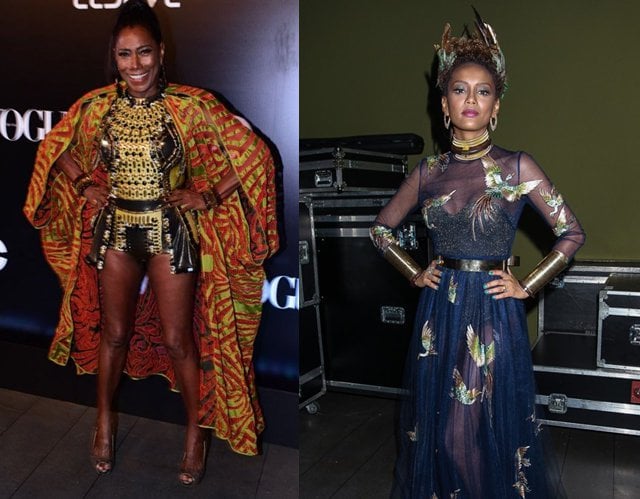
Journalist Glória Maria and actress Tais Araujo were two of the few black faces at the event
This month’s edition brought the model and black woman Jourdan Dunn. In an attempt to compensate for any embarrassment and around the gaffe, they invited a black actress and a black host, respectively Taís Araujo and Glória Maria. They were present but, however, were not seen as beautiful, because Vogue itself elected four muses for the party and of these only ONE was not white! We don’t serve to be elected as beautiful, but our culture is to be appropriated, that’s what Vogue said. They posted “African pop” clothing style tips and on top of that an editorial of how do makeup for “morena” skin featuring a black woman (2).
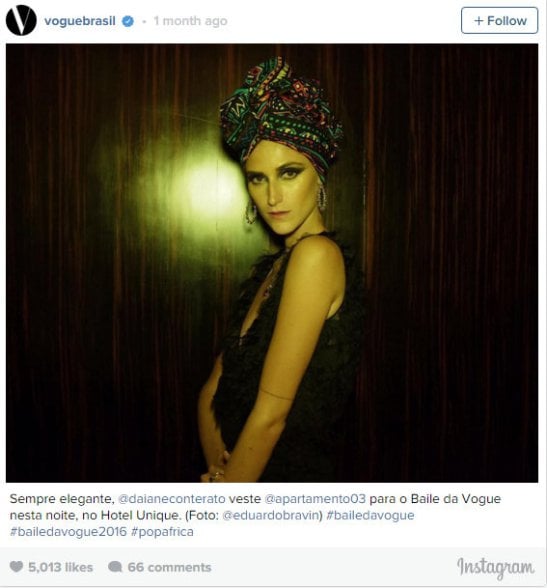
It is unfortunate that the national elite is so ignorant and have such bad ideas as thinking that being African is some costume or character, believing that this is some kind of “genius” and homage. The look on the black population that the magazine shares is explicit in this picture to promote the event, where the black women are mere background, landscaping for the white model (see here).
Something that is also popular in Brazil are parties with black names, but performed in middle-class neighborhoods with a middle-upper class public almost 100% white. Reaffirming the maxim that black culture is popular, but not black people.
Even with the blatant racism in society, killing and destroying realities, it seems that a part of Brazil prefers to have parties offensive to blacks, celebrating the satire itself that they made of África among its guests, than to worry about a harmful reality where being black in the day-to-day is not to dress oneself as a character and parade in an elite environment, but it is to be confused for a criminal for the simple fact of walking in the street.
BEING black is not a choice, it’s not an ink that flows in the bath nor a clothing of which one divests at any given time. Being black is an identity, a permanent state of resistance, pride and celebration.
Finally, Vogue France took five years to have a new cover with black women (2010 – Rose Cordero and in 2015 – Liya Kebede); Vogue Italy in 2014, was denounced for racism after using blackface in an editorial. In 2016 we have Vogue Brasil producing a party where it practically begged the guests: be racists!
Fashion is also about inclusion, engagement and elegance, but it appears that Vogue, in the category of sensitivity, leaves much to be desired when it shows the commitment in terms of what it inclines itself to honor. It lacked generosity to go search in África (and in black people) its inspiration, left disrespect in so many ways that a guest came to wear a a black doll tied on their back as part of their “costume”.
The elements that we saw at the ball show that there was lack of interest for theme culture.
Do you know when a job is done in a hurry?
Well then, it failed!
Source: Brasil Post
Note
- Vogue Brasil seems to be competing with Playboy Brasil in this regard. But the fact is that this is the standard for ALL Brazilian magazines except one that is actually targeted at the Afro-Brazilian population.
- The dispute over referring to black Brazilians as ‘morenos’ and ‘morenas’ is a common topic on this blog and key to understanding racial identity and classification in Brazil.




